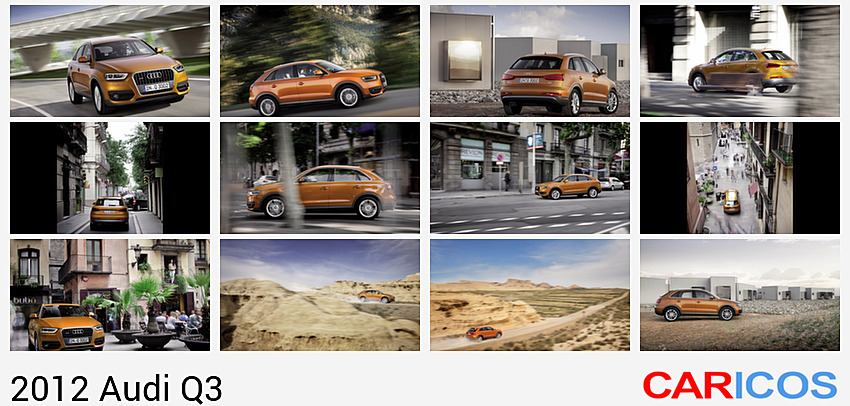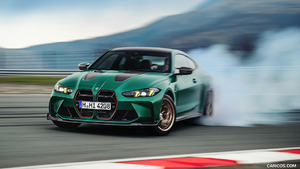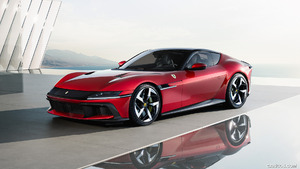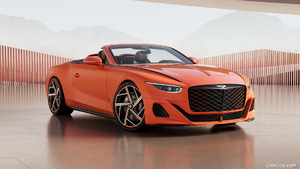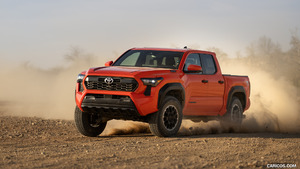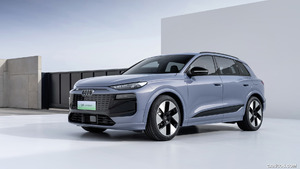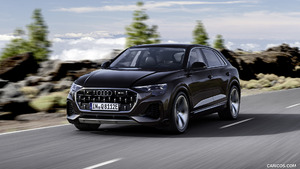2012 Audi Q3
The new Q3 is a premium SUV in a compact form. Its body, the drivetrains, the chassis and the highly advanced assistance and multimedia systems reflect the competence of Audi. The Audi Q3, the youngest member of the successful SUV family from Audi, is a practical companion for everyday – an urban model that feels at home anywhere. Its versatile character makes it attractive to a wide range of customers.
Exterior design
Robust, powerful, sporty – the Audi Q3 has a distinctive road stance. Its progressive design is tightly integrated into the brand’s design language. Audi is known for bringing many ideas and innovations from its show cars to production vehicles. The Q3 takes up the concept of the 2007 Cross Coupé quattro showcar.
Its dimensions express the dynamic lines in numbers. The compact SUV is 4,385 millimeters long (14.39 ft) long and 1,831 millimeters (6.01 ft) wide, but only 1,590 millimeters (5.22 ft) high (without antenna and roof rail). The wheelbase measures 2,603 millimeters (8.54 ft); the overhangs are short. The coupe-like roof line and the sharply sloped D-pillars give the Q3 a thoroughly sporty silhouette.
The front end of the vehicle is intensively sculpted and sets strong accents. The upper corners of the single-frame radiator grille are beveled, and the lattice is dominated by the vertical elements. Two rising lines on the side carry over into the engine hood. The large air inlets with the horizontal bars underscore the powerful appearance of the compact SUV and harbor the standard fog lights.
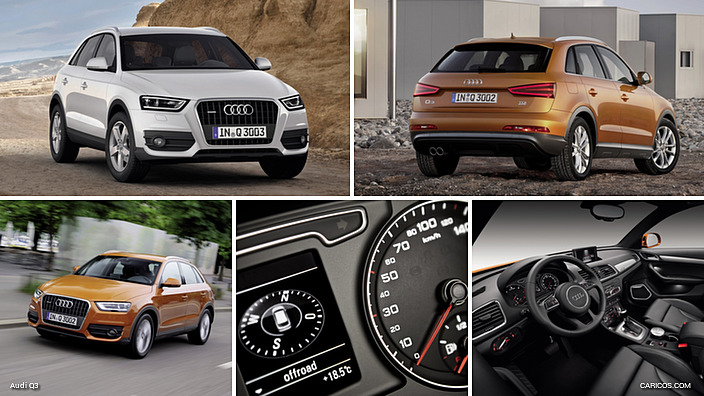 2012 Audi Q3
2012 Audi Q3
Like its big brothers, the Q5 and the Q7, the headlights of the Audi Q3 are wedge-shaped. They are set deeply into the body, and the turn signals are located behind an intricate fascia vapor coated with aluminum.
As with every Audi, daytime running lights are standard with the standard halogen headlights. With the optional xenon plus units, the daytime running lights are implemented as two light-emitting diodes that together consume only 10 watts and whose light is radiated via a light guide. The light guide forms a flat, U-shaped clasp that is open to the outside.
The headlights can be paired with the optional high-beam assistant – a first in the compact SUV segment. The system uses a small camera to detect other vehicles and automatically changes between the high and low beams. Another high-end option is adaptive light, the dynamic cornering light.
In the style of a coupe: the roof
The side view is dominated by the flowing, coupe-like roof that quickly begins sloping back downward. It flows into an unusually flat D-pillar reminiscent of the A3 models. The pillar lends the rear an energetic look that is further accentuated by the long roof spoiler. The sheet metal to greenhouse ratio of two-thirds to one-third is also typical of Audi’s sporty design language. The pronounced wheel arches with the offset wheel wells house wheels up to 19 inches in diameter.
Sharply drawn lines on the flanks frame athletically arched sheet metal surfaces. Their wedge-shaped path gives the Q3 a lean and fast appearance. The defining shadow contour is the tornado line. It begins at the headlights and runs below the edge of the window to the tail lights. The dynamic line above the side sills is also an element of the Audi brand library. Another line in the area of the sills further heightens the tension. The door handles are distinctly bow-shaped, and the housings of the side mirrors sport LED turn signals.
The wrap-around tailgate emphasizes the width of the Q3’s rear end – a characteristic feature of the Q model series. The tailgate has a three-dimensional look, drawing back several centimeters above the license plate. The electric button to unlock the tailgate is located beneath this edge.
The large, undivided tail lights – another distinguishing feature of the Q models – have a wedge shape similar to the headlights and feature a three-dimensional look that is continued in their interior.
Audi offers LED tail lights in combination with the xenon plus headlights. Two high-performance LEDs which require just two watts of power generate the rear light – a flat bar in the style of the daytime running lights – by means of light guides. 21 yellow LEDs are used for the turn signal, 18 red ones for the brake light – whose immediate response provides added safety for drivers following behind.
Thanks to the colored housing, the LED tail lights are very dark red when switched off. Because they cannot be seen when the luggage compartment hatch is open, the Q3 also has flat lamps with incandescent bulbs integrated into the bumper.
An underbody guard caps the bottom of the rear end, giving the compact premium SUV a sturdy road stance. The exhaust system terminates in dual tailpipes on the left. The entire exhaust system is very lightweight thanks to the low wall thicknesses made possible by high-grade stainless steels.
Broad palette: 11 paint colors
Audi finishes its compact SUV in 11 colors. The solid finishes are Amalfi White and Brilliant Black; the metallic and pearl-effect colors go by the names of Ice Silver, Glacier White, Caribou Brown, Cobalt Blue, Monsoon Gray, Phantom Black, Platinum Beige, Samoa Orange and Sphere Blue.
The add-on parts – the wheel wells and the front and rear underbody guards – are available in a choice of three colors. They come standard in black, but Audi offers both anthracite and the body color as options. Another option is tinted privacy glass for the rear windows. The high-gloss package that comes standard on all models equipped with the two most powerful engines provides elegant touches around the windows.
Two large packages round out the lineup. The Audi exclusive off-road styling package lends the Audi Q3 a particularly wide and powerful appearance. The trim strips on the doors and the flared wheel wells are Stone Gray, and grilles with impact strips are mounted in the air inlets.
The underbody guard is made of stainless steel, and the bottom of the rear bumper has been redesigned. Special 18-inch wheels from the Audi exclusive line complete the robust look.
The S line exterior package, on the other hand, has classic appeal to particularly sporty customers. It includes modifications to the front apron and the bottom of the rear bumper, into which a diffuser is integrated. Chrome elements add sparkle to the fog lights, the vertical struts of the single-frame grille and the exhaust tips. The air inlets are black, while the door trim strips and bumpers are finished in the body color. The front bumpers and the door sills sport S line badges.
Body
The body of the Q3 establishes the foundation for the high build quality, the sporty handling, the acoustic comfort of the cabin and safety. Large portions of it are made of high-strength steels, which are a decisive factor for the high static and dynamic rigidity. Two torsion rings – in the area of the rear seats and the cutout for the tailgate – also make significant contributions here.
Audi once again demonstrates its competence in “ultra” lightweight construction with the Q3. The front-wheel drive version of the compact SUV, scheduled to appear somewhat later, weighs 1,445 kilograms (3,186 lb), with the body-in-white accounting for just 301 kilograms (664 lb). Even the add-on parts are lightweight. The engine hood and the wrap-around tailgate are made of aluminum. They weigh just 8.8 and 10.8 kilograms (19.40 and 23.81 lb), respectively – nearly 50 percent less than corresponding parts of steel sheet. The engine hood is secured to the body by two releases, allowing a crash-optimized construction with low sheet thicknesses and high geometrical stability.
The occupant cell integrates numerous panels with tailored thicknesses (tailored blanks). 74 percent of all panels in the body are made of high-end steels. Topping the materials pyramid are the hot-shaped steels. The blanks are heated in a furnace to over 900 degrees Celsius (1,652 degrees Fahrenheit) and shaped immediately thereafter at around 200 degrees Celsius (392 degrees Fahrenheit) in a water-cooled pressing die.
The abrupt change in temperature imbues the finished panels with a tensile strength of up to 1,550 megapascals – the same as the cables of a suspension bridge. A single wire with a cross-section of one square millimeter can suspend a weight of 150 kilograms (331 lb). The martensitic structure of the panels can only be machined with a laser or diamond-coated tools.
Hot-shaped steels, which because of their strength require only relatively low wall thicknesses, make up 13 percent of the body. They are used in the transition from the front end to the occupant cell, at the center tunnel, in large areas of the roof frame, for the interior sills and for the B-pillars. The latter are each formed from a single blank, but undergo different heat treatments in different areas. As a result, their strength varies in three zones so that the B-pillars offer optimal protection in a side-impact collision.
One factor for enhanced rigidity is 74 meters of structural adhesive. The adhesive bonds supplement the 4,400 weld points and provide for strong and tight connections, often eliminating the need for additional sealing and corrosion protection measures – which in turn saves weight.
The seam around the water outlet at the trunk and the invisible seam between the side panel and the roof – two particularly problematic areas – are made using the laser beam or the plasmatron brazing process. Audi performs both high-end processes with exacting precision. The roof joint strips are eliminated. Laser welds also join the frame and the interior portions of the doors.
Carefully matched: vibrational comfort
The development engineers precisely matched the resonant frequencies of the body and those of the add-on and internal components to give the Q3 its excellent vibrational comfort and acoustics. Bulkheads and lightweight materials such as foams and spray insulation divide large cavities like the D-pillars and have a calming effect on the large sheet metal surfaces. In addition to the good acoustic properties, these measures offer the added advantage of saving two to three kilograms (4.41 to 6.61 lb) of weight compared to thick film coatings.
Particular attention was focused on sound radiation in all areas where the driver and front-seat passenger are in contact with the car, such as the seats, parts of the floor and the steering wheel.
The engineers use state-of-the-art simulation tools and computational methods in all fields of work. For example, they were used to develop a reinforcement for the tailgate latch with molded bulkheads that significantly reduces the sound radiation of the tailgate. Another factor contributing to the low noise level on board the Q3 are the sophisticated seals at the doors and windows, plus numerous geometric details of the body. Audi also offers an acoustic windshield with a noise-damping intermediate film as an option.
Enhanced safety: excellent occupant protection
The Audi Q3 is also at the head of its class when it comes to passive safety. There are three load levels in the front end. The lowest one comprises the subframe for the front axle. Two longitudinal members are used on the middle level. Connected to one another via the front cross-member, they distribute the load in an offset crash to both sides of the occupant cell. On the top level, two additional members dissipate energy via the fenders.
The ultra-high-strength B-pillars provide outstanding protection in a side-impact collision. Large overlaps brace the doors against the pillars and the triple-shell sills. Two cross-members reinforce the floor structure. The longitudinal members absorb energy in the event of a rear-end collision. Their strength gradually decreases moving forward. The members can be replaced in sections, which reduces costs.
Five crash sensors that react to acceleration and changes in air pressure stand guard in the Audi Q3. One of them is located at the center of the front end, the other four in the area of the B- and C-pillars. They provide detailed information to the airbag controller, which itself includes three sensors.
The compact premium SUV comes standard with two front airbags, thorax-pelvis side airbags in the backs of the front seats and curtain head airbags. Pyrotechnic belt tensioners up front, belt force limiters and the integral Audi head restraint system, which mitigates the consequences of a rear-impact collision, round out the package. Side airbags in the rear are optionally available.
Isofix child seat anchor points in the rear are standard. Sensors monitor whether the rear safety belts are fastened. Isofix child seat anchor points for the front passenger seat together with deactivatable airbag are optionally available. The accessories line includes child seats for every age group.
Audi’s latest model also represents the state of the art when it comes to pedestrian protection. The front bumper and the cross-member behind it, the energy-absorbing foam between the two components and the aluminum engine hood make for an effective package.
Low-speed collisions – the standard insurance category crash and the bumper crash, both of which are important for determining the comprehensive insurance category – result in no major damage. The front cross-member and the crash boxes bolted to the longitudinal members are closed, extruded sections of aluminum. They form a structure that provides effective protection for expensive components such as the radiator and air conditioning units, as well as the welded body structure. The bumper is made up of three parts, each of which can be replaced individually.
Extremely sophisticated: the aerodynamics
The base version of the Audi Q3 boasts a coefficient of drag of 0.32 – tops among its competition. It has a front surface area of 2.44 square meters (26.26 sq ft). The low lift at the axles ensures superior stability at high speed.
The aerodynamic specialists at Audi performed exhaustive fine-tuning with their virtual tools and at the Wind Tunnel Center. They reduced the coefficient of drag by 0.16 from the first design model of the Q3. This resulted in a reduction in fuel consumption of 0.6 liters per 100 km in the EU cycle. At 130 km/h, the result is an even more impressive reduction of 2.3 liters per 100 km.
The greatest challenge proved to be the rear of the car, the zone in which the flow of air has to break off cleanly. The large spoiler with the integrated third brake light over the rear window extends the roof contour by 32 centimeters (12.60 in). Two “aero strips” to the left and the right of the window form lateral spoiler lips. Their black, high-gloss finish lends them a subtle and elegant appearance. The vertical contours in the tail lights serve similar purposes.
Very sophisticated aerodynamic tuning also went into the side mirrors. With their elegant design and slender base, they contribute just 3.1 percent of the total wind resistance. The noise generated at the mirrors remains low, and the glass barely fouls in the rain. The water-catching strips at the A-pillars keep the side windows clean by diverting the rain water pushed in their direction by the windshield wipers downward or upward.
The underbody also plays a major role in the aerodynamics concept. Except for the exhaust system and the back of the vehicle, it is covered by a plastic liner that protects it against salt and stone chipping and provides for a more aerodynamic flow of air. Small spoiler lips are integrated in front of the wheels. The aerodynamic underbody lowers the coefficient of drag by 0.03 or nine percent, and is precisely matched to the flow separation at the rear of the vehicle.
The aerodynamics experts also pared further valuable percentage points from the flow of air through the engine compartment. The single-frame grille and the surrounding area are completely sealed so that the inflowing air reaches the radiator with almost no losses rather than becoming turbulent.
Interior
The interior of the Audi Q3 mirrors the exterior design’s sinewy and muscular styling. The wrap-around, a large arc above the dashboard and extending from one front door to the other, is a design feature borrowed from the brand’s large model series. The elegantly sweeping, horizontally stepped instrument panel features a large inlay on the passenger side.
The broad center console is asymmetrical and inclined slightly toward the driver. The clean layout and intuitive operation of all switches and controls on it – the control unit for the audio or MMI system, the strip with the secondary switches and the terminal for the air conditioning – are exemplary.
Manual air conditioning is standard. Deluxe two-zone automatic air conditioning that considers the position of the sun and humidity is available as an option. The large controls, which are spring-loaded, are an optical and tactile highlight. A display indicates the temperatures in each zone. The transition to the center console is home to the start-stop button for the ignition, which Audi packages with the optional convenience key.
The 6.5-inch or 7.0-inch display (standard with the concert radio and upwards), is retracted into the instrument panel. If you tap the top edge of the retracted monitor, it extends upward in a gentle, even motion into an excellent position where it can be read quickly. The fold-out monitor with its high-gloss black frame is a visual and technical highlight in the compact SUV class.
The instrument cluster beneath the rounded cowl also speaks the elegant Audi design language. The speedometer and the tachometer, into which the coolant temperature and fuel level indicators have been integrated, have black dials, white numbers and red needles. At night the instruments are lit in white, the buttons red.
Between the instruments is the center digital display. The optional Audi driver information system is available with a white or color display. The system pools all key information from the audio sources, the telephone, the vehicle and the navigation system. It is broken down into three display areas. An intelligent tab concept makes it very easy to use.
Integrated into the driver information system is the on-board computer with efficiency program. The computer gives the driver tips for fuel-efficient shifting. In models with a manual transmission, an enlarged representation of the gear-change indicator indicates when it is appropriate to shift gears. Another function provides information on which on-board consumers, such as the air conditioning or the rear window heating, are active and how they affect fuel consumption.
The Audi Q3 showcases the new generation of steering wheels that debuted in the A8 luxury sedan. They can be adjusted over a range of 50 millimeters (1.97 in) vertically and horizontally, feature a lightweight magnesium skeleton and come wrapped in leather as standard.
The split bottom spoke of the three-spoke sport steering wheel is an eye-catching and exclusive feature of the Q model family. The two upper spokes can be optionally equipped with paddles, buttons and rotating cylinders that the driver uses to control the on-board computer, the telephone and the audio system. Shift paddles for S tronic are another option.
Firm hold: the seats in the Q3
The front seats in the Audi Q3 offer excellent hold, guidance and support for persons of all sizes. Height-adjustable seats are standard. Options include power lumbar supports, heating and full power adjustment. The strongly bolstered sport seats feature adjustable seat cushion rake and length and come standard with a power lumbar support.
The rear seats are also comfortably shaped and upholstered for a pleasant, upright seating position. Their head restraints can be extended particularly far and lowered far enough so as not to impair the view in the rearview mirror. Despite the sloping, coupe-like roof line, even tall passengers enjoy sufficient headroom in the back, and there is also ample room for feet, knees, shoulders and elbows. Getting in and out of the vehicle is easy thanks to the raised seating position. The stepless door stops are very helpful in garages and narrow parking spots.
The Q3 offers plenty of storage at all of the seats. The console of the center tunnel is home to two cup holders, a 12-volt outlet and a storage bin. There are large pockets in the doors capable of holding 1.5-liter bottles, and there is a small, fold-out compartment to the left of the steering wheel. The base model has an additional compartment on the instrument panel rather than the on-board monitor. A height-adjustable center armrest is optionally available.
The optional storage package offers even more convenience. It includes fold-down compartments under the front seats, storage nets on the front seat backs, a multi-purpose retaining hook in the passenger foot well and a locking glove box.
Premium: the build quality
Evidence of the premium character of the Audi Q3 can be seen in every last detail in the interior – in the selection of the materials, in their processing and in the tight, even gaps. The surface of the instrument panel is softly backed with foam and elegantly textured. All buttons and controls move precisely. The subtle click sounds they make when actuated give audible expression to their technical perfection.
The finely honed interior is visually impressive. Many control elements are available in either standard or optional aluminum-look finishes, including the knobs of the automatic air conditioning, the knob for the lights, the trim around the power window switches and the frames around the door openers and the air vents. A leather-covered shift/selector lever with aluminum inlays is standard.The round knob on the short selector lever of the S tronic lends it a particularly robust appearance.
Another exclusive solution in this segment is the LED interior lighting package – a technology that bathes the interior in dramatic light. Efficient white light-emitting diodes provide the cabin and reading lights. They illuminate the doors, the headlining, the foot wells, the vanity mirrors, the storage compartments and the air vent thumb wheels. LED light guides even accentuate the cup holders. With the Bose surround sound system, the frames of the woofer/mid-range speakers in the front doors form elegant rings of white light.
A tasteful hand when it comes to color and trim is also a matter of honor for Audi. Five interior color combinations are available – black/black, black/chestnut brown, black/chennai brown, black/titanium gray and truffle beige/pistachio beige. Q3 customers choosing the base version can order platinum-colored applications. Seats in pistachio beige have inlays in truffle beige.
Monometallic plastic inlays are standard. Audi also offers a choice of optional materials that underscore its leadership in interior design. The structure of the dark brown, open-pored larch wood has an authentic look and feel. The material 3D aluminum mesh uses a wire mesh to achieve a silvery-transparent look with a three-dimensional effect. Walnut and Aluminum Satellite – made from perforated aluminum – are other options.
There is also a wide choice of seat coverings. Besides the standard cloth, Audi also offers a second cloth variant and two grades of leather: Milano and Fine Nappa. The sport seats are also available in Pearl Nappa leather/Alcantara.
One upscale option is the S line sport package, which immerses the entire cabin and headlining in dynamic black. The floor mats feature gray piping, the door panels are covered in cloth, and inlays are available in a choice of brushed aluminum or piano finish.
The cloth seats feature embossed coverings in Sprint cloth and leather, and are optionally available in leather/Alcantara or Fine Nappa leather. The leather sport steering wheel and shift knob feature a special design, and S line logos adorn the door sill strips.
Exterior features of the S line sport package are 18-inch wheels from Audi exclusive, a sport suspension that lowers the body 20 millimeters (0.79 in) and badges on the front fenders. An exclusive Daytona Gray metallic finish is also available.
Practical: cargo area
The cargo area of the Audi Q3 can be used very efficiently. Its side walls are virtually plane, and at 781 millimeters (30.75 in), the loading lip is relatively low. Because the shock absorbers are located far to the outside in the body, the compartment is very spacious, offering a pass-through width of 1,067 millimeters (42.01 in).
In its standard configuration, the luggage compartment has a volume of 460 liters (16.24 sq ft). A two-piece, removable cargo area cover hides the contents from view. The split rear seat backs can be folded down quickly and easily in just one step without having to remove the head restraints. When loaded to the roof, cargo volume in this configuration increases to 1,365 liters (48.20 cu ft).
The tailgate opens electronically, including via the remote key fob, and swings up very high. A handle running the width of the tailgate makes it very easy to close again, and it latches with a satisfyingly solid sound. Its clasp has a spring-loaded cover that keeps it from getting dirty – another typical Audi detail, just like the high-quality coverings on the side walls and the cargo floor.
Many features make the cargo area even more practical. Two large hooks, four lashing eyes and a small storage compartment in the left wall are standard. Options available from Audi include a reversible cargo floor with a tub on the reverse side, a reversible mat, stainless steel loading edge trim and a cargo area package that includes a luggage net, a side-mounted net, a 12-volt outlet and a second light.
Another option is the pass-through hatch in a package with an armrest and cup holders. It can be supplemented with a ski bag. Customers who often transport large, bulky objects can order the passenger seat with a folding seat back. The optional trailer hitch has a swiveling ball neck that can be conveniently unlocked using a button in the cargo area.
The Audi Q3 has a maximum towing capacity of two metric tons, depending on the engine. The maximum roof load is 75 kilograms (165.35 lb). The standard roof rail, which comes in either black or anodized aluminum depending on the engine, can be fitted with a wide range of racks for bikes, skis, kayaks and other sports equipment from the Audi accessories program.
Multimedia systems
The Audi Q3 is the premium SUV in the compact segment, and its range of infotainment and multimedia systems taken directly from the luxury class underscores this status. As is typical for Audi, it follows a modular concept in which the components of the modular platform can be combined.
The chorus radio is the standard radio in the Q3. It offers a CD player that can also read mp3 formats and also has an Aux-in connection in the storage compartment in the center console. The chorus radio delivers its sound to eight passive speakers.
The concert radio is the first optional module. Its operating logic follows the MMI principle from the large Audi model lines. The manual fold-out monitor – a 6.5-inch color display – and a memory card reader are standard at this level. The concert radio has a tuner with phase diversity and a TMC tuner.
Audi offers the optional connectivity package featuring navigation system preparation in conjunction with the concert radio. The hardware is preinstalled, and the customer can activate the system at any time. An SDHC card with map data turns the radio into a navigation system. The connectivity package also includes a Bluetooth interface and the Audi music interface for the easy connection of a mobile player.
High-end media center: MMI navigation plus
Topping the infotainment lineup is MMI navigation plus, a high-end media center that is unmatched in this vehicle class. It comprises four primary components – the main unit with a 60 gigabyte hard drive, the radio unit, the MMI control terminal and the color display.
Thanks to its high 800 x 400 pixel resolution, the 7.0-inch monitor displays extremely sharp images. Graphics, including the cover art for the audio titles and the wizards for the main menus, are elegantly sculptured, as is the navigation map with many city models and points of interest.
A large rotary pushbutton is at the center of the MMI control unit on the front of the MMI navigation plus. It can be rocked like a joystick, which makes many functions even more convenient. Arranged around the pushbutton are the volume control, four soft keys and eight hard keys. The latter provide fast access to the Vehicle, Sound, Radio, Media, Menu, Telephone, Navigation and Info functions.
The MMI navigation plus system can store 20 GB of music on its hard drive. It includes two SDHC card readers and uses a Bluetooth interface and the Audi music interface to connect external players. The system also has a drive for audio and video DVDs and a voice control system that understands 12 languages. The driver can speak the destination address all at once, and also control the main radio, media and telephone functions by voice. The system’s on-board monitor can also display Cyrillic, Chinese and Japanese characters.
A number of additional modules are available for MMI navigation plus and the concert radio: a Bluetooth interface, a six-disc CD changer and a dual tuner for DAB (Digital Audio Broadcasting) reception. A Bluetooth cellular phone preparation kit connected to the car’s antenna makes using the phone convenient. The top-of-the-line system can also be supplemented with an analog/digital TV tuner.
Two high-end sound systems are available for the Audi Q3: the 180-watt, six-channel Audi sound system with ten speakers and the Bose surround sound system. The latter features a ten-channel receiver delivering 465 watts of power to 14 speakers, including a subwoofer. Their neodymium magnets combine powerful performance with low weight. The system uses a special algorithm to play stereo signals as 5.1 surround sound. Its amplifier uses a microphone to analyze intrusive noises and adjusts music playback accordingly.
From the concert radio up, Audi networks all of these systems using a MOST bus, in which the controllers are arranged in a ring and communicate with one another via fiber-optic cables. Designed specifically for the transfer of media data, the MOST bus is extremely flexible and makes it possible to also retrofit complex add-ons, such as navigation or Internet functions.
Audi connect
Audi connect is the term used for the networking of the automobile with its surroundings, and the brand with the four rings is a leader in this field, too. The Bluetooth online car phone will be available in the Q3 somewhat later as a supplement to the MMI navigation plus. It uses a UMTS module and a WLAN hotspot to connect the compact premium SUV to the Internet.
The UMTS module, which is integrated into the head unit of the MMI navigation plus system, establishes the connection to the special Google services and to the World Wide Web and retrieves news, travel and weather information. Drivers can plan their routes on their computers at home or in the office, upload them to a special section of the Internet site www.audi.com and download them from there on starting the trip.
The navigation system uses the fast UMTS connection to also load satellite and aerial photographs from Google Earth. They appear on the monitor in a bird’s eye view or top-down view superimposed over the map. In addition, photos, descriptions and supplemental information about search results can also be called up.
The WLAN hotspot allows the passengers in the Audi Q3 to connect up to eight mobile end devices – from laptops to smart phones – to the Internet. Communication is via the roof antenna for enhanced quality and stability. A special modulation method called High Speed Downlink Packet Access (HSDPA) enables UMTS data transfers at up to 7.2 Mbit per second. The connection is secured using the modern WPA2 encryption standard.
All the driver of the Audi Q3 needs to go online is a data-capable SIM card. Alternatively, the driver can connect his or her private cellular phone to the system via Bluetooth if the phone supports the SIM Access Profile. No additional fees or separate contracts are required. Given the high data volumes, however, Audi does recommend a flat rate.
Engines
The Audi Q3 is being launched with a choice of three four-cylinder engines – two TFSI units and one TDI. All three displace 2.0 liters and have power outputs between 125 kW (170 hp) and 155 kW (211 hp). A second TDI with 103 kW (140 hp) will follow somewhat later. The engines in the Q3 follow the Audi philosophy of downsizing, substituting forced induction for displacement to achieve strong performance with low fuel consumption.
All engines come standard with the recuperation system, a solution from the Audi modular efficiency platform. The system uses intelligent voltage control for the alternator to recover energy during braking and coasting phases. The energy is stored temporarily in the battery and flows back into the on-board electrical system, relieving the load on the alternator and thus the engine the next time the car accelerates.
The start-stop system is another Audi efficiency technology. When the Q3 comes to a halt, the control unit shuts down the engine. The driver’s foot must keep the brake pedal depressed (if equipped with S tronic) or be removed from the clutch (if equipped with a manual transmission). A powerful starter restarts the engine quickly when the driver releases the brake or steps on the clutch again.
The start-stop system is only inactive during the engine’s early warmup phase, on steep slopes or if it is extremely cold. Both it and the recuperation system make a significant contribution to reduced fuel consumption.
Equipment
The compact premium SUV rolls off the assembly line with a comprehensive array of standard features. These include a leather steering wheel, manual air conditioning, an electromechanical parking brake, the chorus CD radio with eight speakers, height-adjustable front seats and a radio-controlled central locking system. An extensive package of restraint systems, Isofix child seat anchor points in the rear, hill hold assist plus electrically heated and power-adjustable side mirrors round out the equipment list.
Standard exterior equipment includes 16-inch alloy wheels and a black roof rail. ESP with electronic limited slip differential makes handling even sportier and safer. The start-stop system and the recuperation system enhance efficiency. 36/39 www.audi-mediaservices.com All three versions of the Q3 initially available distribute the engine’s power to all four wheels via quattro permanent all-wheel drive. Models with the two top-of-the-line engines roll off the assembly line with the seven-speed S tronic. 17-inch wheels, a high-gloss package and an anodized aluminum roof rail on the body set sporty and visual accents with the most powerful TFSI and TDI models.
The options also reflect the character of the Q3. They are elegant, sporty, comfortable and practical, with many coming directly from the luxury class. One of these is the panoramic glass roof in the style of the large Audi SUVs, the Q5 and the Q7. It comprises two tinted glass panels. It opens by sliding the mobile front panel back over the fixed rear panel.
A wind deflector reduces noise and drafts. The panoramic glass roof is operated via a four-way switch, and a blind protects against the sun’s rays.
There are a number of high-end lighting options available: xenon plus headlights with LED daytime running lights and LED tail lights, the high-beam assistant including light and rain sensor, and the adaptive light system. Add-on body parts are available in three color variants, and there is a choice of two styling packages.
Tinted rear windows and a noise-damping windshield further increase comfort in the cabin.
Production
Audi began accepting orders for the Q3 in June. The base model – the 2.0 TDI with 103 kW (140 hp) and front-wheel drive that will be available somewhat later – lists for €29,900. The 2.0 TFSI quattro with 125 kW (170 hp) costs €31,550; the two models with the most powerful engines, which are always equipped with quattro all-wheel drive and S tronic, each have a list price of €36,800.

